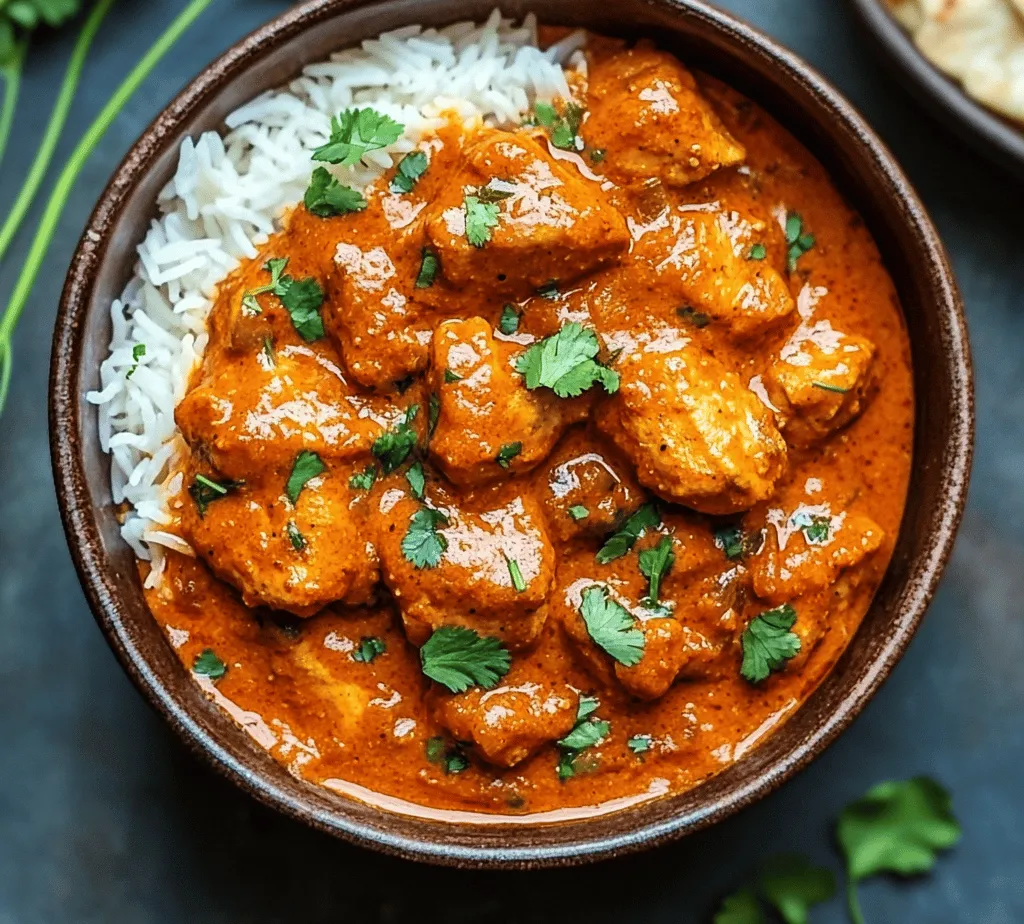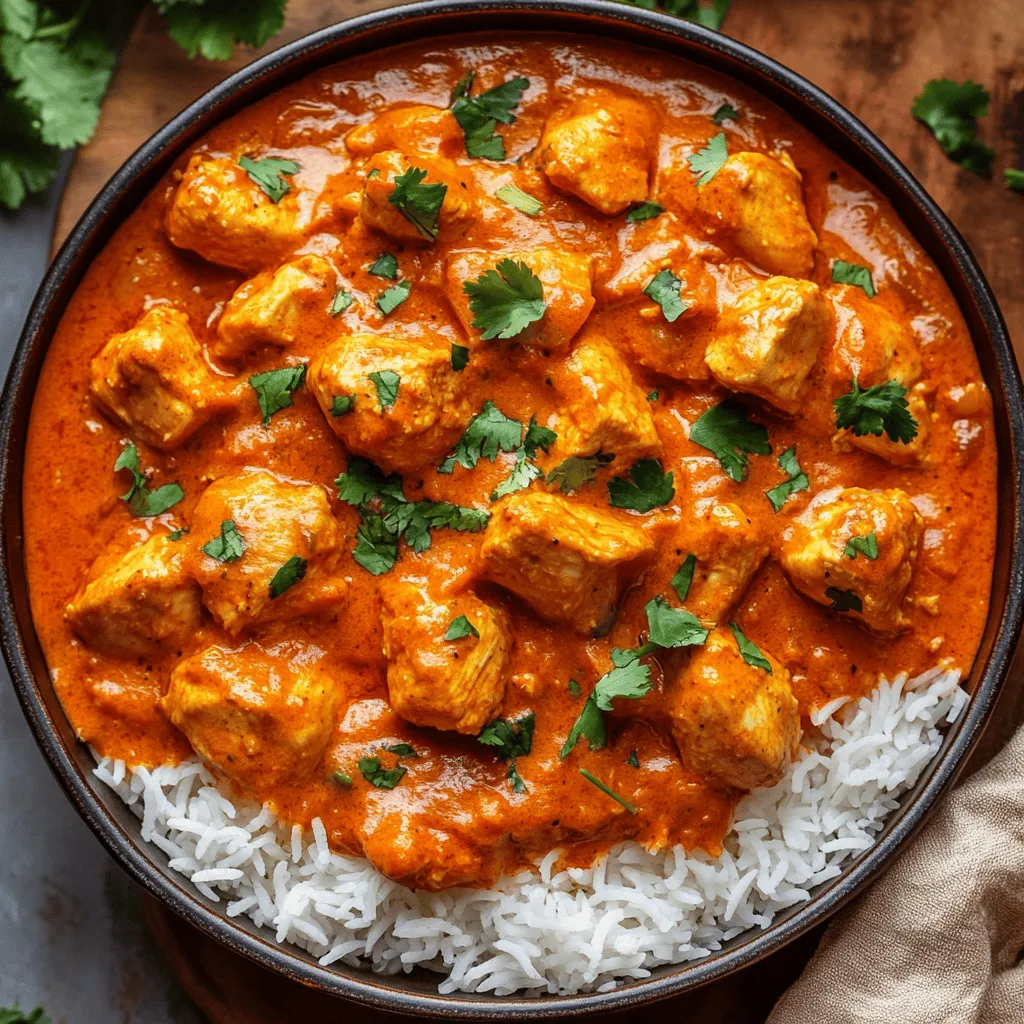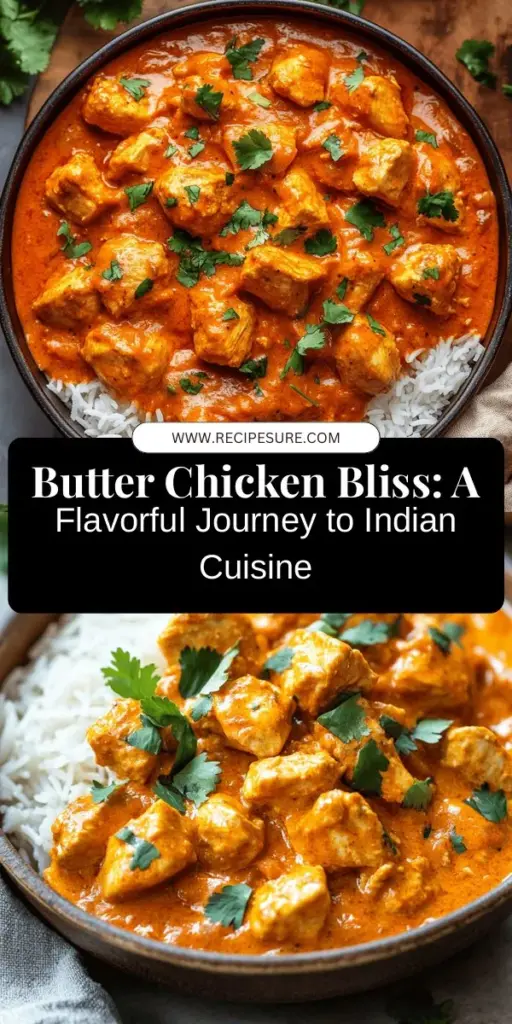When it comes to comfort food that delivers an explosion of flavor, few dishes can compete with Butter Chicken Bliss. This iconic Indian recipe, known for its velvety sauce and tender chicken, is a delightful dance of spices that captivates the senses. Whether you are looking to impress guests at a dinner party or simply indulge in a hearty meal at home, Butter Chicken Bliss is your go-to culinary creation. In this comprehensive guide, we will not only delve into the origins and cultural significance of this beloved dish but also provide you with an easy-to-follow recipe that will have you serving up restaurant-quality Butter Chicken in no time.
The Origins of Butter Chicken: A Brief History
Cultural Significance of Butter Chicken
Butter Chicken, or “Murgh Makhani” as it is known in its native land, holds a special place in the hearts (and stomachs) of many. Originating from the rich culinary landscape of North India, particularly Punjab, this dish is a testament to the region’s vibrant food culture. It is not just a meal; it is a celebration of flavors that reflects the warmth and hospitality of Indian culture. Butter Chicken was created in the 1950s at the Moti Mahal restaurant in Delhi, where leftover chicken was cooked in a tomato gravy along with butter and cream, resulting in a dish that was both luxurious and approachable.
Understanding its Roots in Punjabi Cuisine
Punjabi cuisine is characterized by its robust flavors and generous use of spices, with butter and cream being staples in many dishes. The preparation of Butter Chicken exemplifies this culinary heritage. Traditional Punjabi cooking often includes tandoori meats and rich gravies, and Butter Chicken is no exception. The dish’s creamy texture and aromatic spices make it a favorite among many, transcending regional boundaries and appealing to taste buds around the globe.
The Dish’s Evolution and Popularity Worldwide
Butter Chicken’s journey from a small restaurant in India to a global phenomenon is a fascinating one. As Indian cuisine gained popularity in Western countries, Butter Chicken emerged as a favorite for its rich, comforting nature. It has made its way into countless kitchens and menus worldwide, often being the first dish people try when exploring Indian food. Its adaptability and the ease with which it can be made at home have cemented its status as a staple in many households.
Key Ingredients that Define Butter Chicken
Introduction to Traditional Components
At the heart of every great Butter Chicken are its ingredients. The combination of marinated chicken, a luscious tomato-based sauce, and a blend of aromatic spices creates a symphony of flavors that is both indulgent and satisfying. Understanding the key components will not only enhance your cooking experience but also help you appreciate the nuances of this dish.
The Role of Spices and Dairy in Flavor Development
The magic of Butter Chicken lies in the careful balance of spices and dairy. Garam masala, a fragrant blend of spices, provides the dish with its signature warmth and complexity. Turmeric adds a vibrant golden hue, while red chili powder introduces a subtle heat that elevates the sauce. Cream and butter are essential for achieving that rich, decadent texture, making every bite a delightful experience.
Ingredient Breakdown for Butter Chicken Bliss
Essential Ingredients List
To recreate the unforgettable taste of Butter Chicken Bliss at home, you will need the following essential ingredients:
- Chicken Thighs: Preferred for their juiciness and flavor, chicken thighs provide a tender bite that stands up well to the robust sauce.
- Yogurt: Used for marination, yogurt tenderizes the chicken while imparting a tangy flavor that balances the richness of the dish.
- Spices: A blend of garam masala, turmeric, and red chili powder is critical for achieving the authentic taste of Butter Chicken.
- Tomatoes: Fresh or canned tomatoes form the base of the sauce, contributing sweetness and acidity.
- Cream and Butter: These ingredients create the luxurious, silky texture that Butter Chicken is known for.
- Garlic and Ginger: Fresh garlic and ginger add depth and complexity to the flavor profile.
- Onions: Sautéed onions provide a sweet and savory foundation for the sauce.
Detailed Description of Each Ingredient
- Chicken Thighs: Unlike chicken breasts, which can dry out when cooked, thighs retain moisture and flavor, making them ideal for this dish. Their higher fat content allows them to absorb the spices better, resulting in a more flavorful outcome.
- Yogurt: The lactic acid in yogurt helps break down the proteins in the chicken, leading to a more tender texture. Additionally, the slight tanginess complements the richness of the sauce.
- Spices:
- Garam Masala: This spice mix varies by region but typically includes cumin, coriander, cardamom, and cloves. It encapsulates the essence of Indian cooking, providing warmth and depth.
- Turmeric: Known for its vibrant color and health benefits, turmeric brings an earthy flavor that rounds out the dish.
- Red Chili Powder: Adjustable to your heat preference, this spice adds a kick that contrasts beautifully with the creaminess of the sauce.
- Cream and Butter: These are not just for richness; they also create a smooth mouthfeel that helps to meld the flavors together, making every bite a heavenly experience.
- Garlic and Ginger: These aromatics are essential in Indian cooking. They not only enhance the flavor but also bring a fragrant quality to the dish.
- Onions: Caramelized onions add sweetness and a savory note, forming the backbone of the sauce.
Substitutions and Variations
For those looking to customize their Butter Chicken Bliss, there are several substitutions and variations to consider:
- Alternative Proteins: If chicken isn’t your preference, you can easily substitute with other proteins such as tofu, paneer, or even chickpeas for a vegetarian version. Fish or shrimp can also be great alternatives, though cooking times will vary.
- Vegetarian Adaptations of Butter Chicken: To create a vegetarian Butter Chicken, replace the chicken with paneer or a mix of vegetables such as bell peppers, cauliflower, and peas. The marination process can be skipped for vegetables, but ensure they are still cooked until tender for the best texture.
Marinating the Chicken: The Secret to Flavorful Butter Chicken
Why Marination Matters
One of the most crucial steps in making Butter Chicken Bliss is marinating the chicken. Marination is not just a flavor enhancer; it is a science that transforms the chicken into a tender, flavorful star of the dish. When chicken is marinated, the flavors of the spices and yogurt penetrate the meat, resulting in a depth of flavor that can’t be achieved by simply adding spices during cooking.
The Science Behind Marinating Chicken
The primary purpose of marinating chicken is to tenderize it. The acidic nature of yogurt breaks down protein structures in the meat, making it softer and juicier. This process also allows the spices to infuse deeply into the chicken, ensuring that every bite is packed with flavor. The longer the chicken is marinated, the more pronounced the flavors will be – making this step essential for achieving Butter Chicken Bliss.
Enhancing Flavor and Tenderness
Ideally, marinating the chicken for at least an hour is recommended, but for the best results, aim for a minimum of four hours, or even overnight. This extended marination time allows the chicken to fully absorb the spices and yogurt, resulting in a more flavorful dish. Additionally, the tenderness achieved through this process will make the chicken melt in your mouth.
Step-by-Step Marination Process
To help you achieve the perfect marinated chicken, here’s a detailed breakdown of the marination process:
1. Prepare the Marinade: In a large bowl, combine yogurt with garam masala, turmeric, red chili powder, minced garlic, and grated ginger. Add a pinch of salt to taste. Mix well until you have a smooth marinade.
2. Add the Chicken: Cut the chicken thighs into bite-sized pieces and add them to the marinade. Ensure that each piece is well coated with the mixture.
3. Cover and Refrigerate: Cover the bowl with plastic wrap or transfer the marinated chicken to a sealable bag. Place it in the refrigerator for a minimum of one hour, but preferably four hours or overnight for maximum flavor.
4. Ready to Cook: Once the chicken has marinated, it is ready to be cooked in the flavorful Butter Chicken sauce you will prepare next.
By following these steps, you set the stage for a Butter Chicken Bliss that is not only delicious but also a true reflection of the rich culinary traditions of India. In the next sections of this article, we will guide you through the process of creating the sauce and cooking the marinated chicken to perfection, ensuring that your Butter Chicken Bliss is a standout dish that you will be proud to serve.

Cooking the Perfect Butter Chicken
Preparing the Ingredients
Before diving into the cooking process, preparation is key to achieving the perfect Butter Chicken. Gather all the ingredients and utensils you will need. This not only makes the cooking process smoother but also ensures that you don’t overlook any essential components.
1. Chopping and Measuring Tips: When preparing ingredients, precise chopping is crucial for even cooking. For onions, aim for small, uniform pieces to ensure they caramelize evenly. Garlic and ginger should be minced finely, as this allows their flavors to infuse the dish effectively. A good tip is to use a microplane for ginger and garlic; this technique provides a smooth texture that blends seamlessly into the sauce.
2. Mise en Place: This French culinary phrase means “everything in its place.” Having all your ingredients measured, chopped, and ready to go before starting the cooking process is vital. This practice prevents you from scrambling to find items mid-cooking and helps maintain focus on the task at hand.
Step-by-Step Cooking Instructions
With everything prepared, it’s time to cook your Butter Chicken.
1. Sautéing Onions: Start by heating oil or ghee in a large skillet over medium heat. Add the chopped onions, stirring frequently. The goal is to achieve a golden-brown color, which should take about 8-10 minutes. This caramelization enhances the sweetness of the onions, contributing to the overall flavor of the dish.
2. Adding Garlic and Ginger: Once the onions are perfectly browned, add the minced garlic and ginger to the pan. Sauté them for about 30 seconds until they release a fragrant aroma. Be careful not to let them burn, as this can impart a bitter taste to your sauce.
3. Cooking the Marinated Chicken: Now it’s time for the star of the show. Add your marinated chicken pieces to the skillet, spreading them out to ensure they brown nicely. Cook the chicken for about 5-7 minutes, stirring occasionally. You want the chicken to be browned on the outside, which adds depth to the dish. The chicken will continue cooking in the sauce later, so don’t worry if it’s not fully cooked through at this stage.
Creating the Rich Sauce
The sauce is what elevates Butter Chicken to its iconic status. Here’s how to create that luxurious, creamy sauce.
1. Combining Crushed Tomatoes and Sugar: Once the chicken is browned, pour in the crushed tomatoes. Adding sugar at this point is essential to balance the acidity of the tomatoes. Stir the mixture well, ensuring that the chicken is coated in the tomato sauce. Let it simmer for about 10 minutes, allowing the flavors to meld and the sauce to thicken slightly.
2. Introducing Cream and Butter: Finally, reduce the heat to low and add the heavy cream and butter. Stir gently until the butter melts and combines with the sauce, creating a velvety texture. This is the moment where your Butter Chicken transforms into a rich, indulgent meal. Allow it to simmer for an additional 5 minutes, adjusting seasoning with salt and pepper to taste.
Serving Suggestions: Elevating Your Butter Chicken Experience
Best Accompaniments for Butter Chicken
To complement the rich flavors of Butter Chicken, the right sides are essential.
1. The Role of Basmati Rice: Basmati rice is a classic pairing with Butter Chicken. Its light, fluffy texture and subtle nutty flavor beautifully balance the richness of the dish. To prepare, rinse the rice under cold water until the water runs clear to remove excess starch, then cook according to package instructions. Fluff it with a fork before serving to enhance its texture.
2. Other Traditional Sides: Besides rice, naan or roti serves as a perfect accompaniment. These Indian flatbreads can be used to scoop up the chicken and sauce, adding an interactive dining experience. You could also serve a side of lentils (dal) or a simple cucumber salad for a refreshing contrast to the creamy sauce.
Garnishing for Presentation
Presentation can elevate your Butter Chicken from simply delicious to truly stunning.
1. Importance of Fresh Cilantro: A sprinkle of freshly chopped cilantro on top of your Butter Chicken not only adds a burst of color but also provides a fresh flavor that cuts through the richness of the sauce.
2. Tips for Plating: When plating, consider using a wide, shallow bowl to showcase the sauce. Spoon the Butter Chicken in the center, then surround it with a generous serving of basmati rice. Garnish with cilantro and perhaps a drizzle of cream for an elegant touch. A wedge of lemon on the side can also add a pop of color and an option for those who enjoy a hint of acidity.
Nutritional Insights: Understanding Butter Chicken Bliss
Nutritional Breakdown
While Butter Chicken is known for its rich flavors, understanding its nutritional content is important for health-conscious diners.
1. Overview of Calories, Protein, and Fat Content: A typical serving of Butter Chicken contains approximately 400-500 calories, depending on the amount of cream and butter used. It is also a good source of protein due to the chicken, providing around 25-30 grams per serving. However, be mindful of the fat content, which can be elevated due to the cream and butter.
2. Healthier Alternatives and Modifications: For those looking to lighten the dish, consider using low-fat yogurt in place of heavy cream. You can also add more vegetables, such as spinach or bell peppers, to increase the nutritional value while still retaining the delicious flavors.
Cultural Context of Butter Chicken in a Meal
Understanding the cultural significance of Butter Chicken enhances the overall dining experience.
1. Its Place in Indian Meals and Celebrations: Butter Chicken, known as “Murgh Makhani,” originated in Delhi and has become a staple in Indian cuisine. It is often served during special occasions and family gatherings, symbolizing warmth and hospitality.
2. Pairing with Beverages for a Complete Experience: Traditional pairings with Butter Chicken can include a sweet lassi, a yogurt-based drink that helps balance the spices, or a light lager beer. For a non-alcoholic option, a refreshing mint lemonade can be an excellent choice to cleanse the palate.
Conclusion: Enjoying the Richness of Butter Chicken Bliss
Indulging in Butter Chicken Bliss is not just about enjoying a meal; it’s about experiencing a rich tapestry of flavors and traditions. This beloved dish encapsulates the essence of Indian cuisine, with its harmonious blend of spices, creamy texture, and tender chicken. Through this comprehensive guide, you can now replicate this iconic dish in your own kitchen, bringing a taste of India to your dining table. Whether shared with family or savored solo, Butter Chicken Bliss invites you to explore the warmth and vibrancy of Indian cuisine. Enjoy every flavorful bite!


